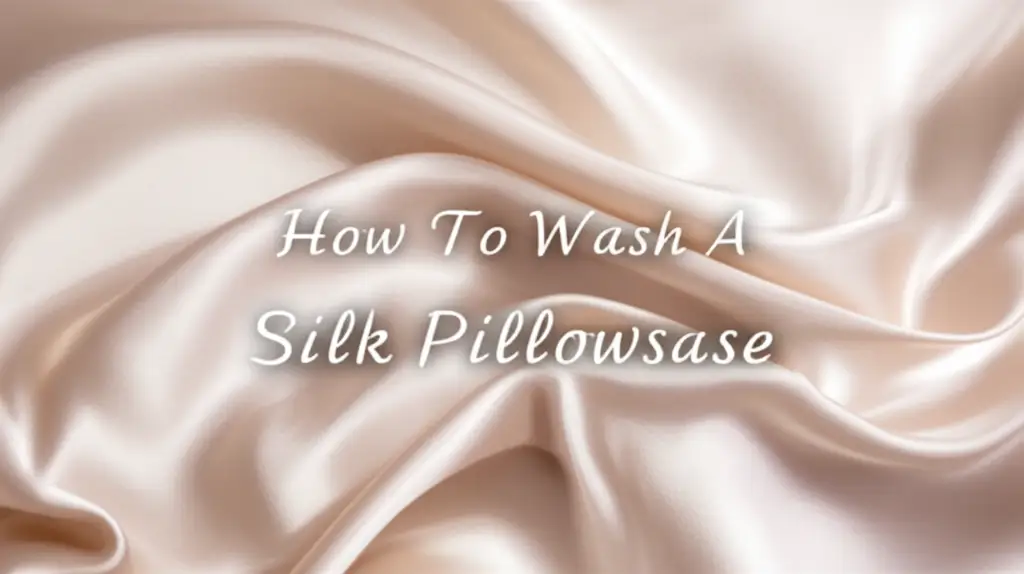· Home Cleaning · 14 min read
How To Wash A Silk Pillowcase

How To Wash A Silk Pillowcase Safely
A silk pillowcase is more than just bedding. It is a touch of luxury. It offers benefits for both your skin and hair. Many people choose silk because it reduces friction. This means less hair breakage and fewer sleep creases on your face. To keep your silk pillowcase soft and beneficial, you must wash it correctly.
Washing silk requires a gentle approach. Improper care can damage the fabric. It can make your expensive pillowcase lose its shine and softness.
This guide provides clear instructions on how to wash a silk pillowcase. We will cover hand washing and machine washing methods. You will learn the best ways to dry and maintain your silk. By following these steps, your silk pillowcase will stay beautiful for many years.
Takeaway:
- Always use cold water and a pH-neutral, gentle detergent for washing silk.
- Hand washing is the safest method to protect delicate silk fibers.
- If machine washing, use a mesh laundry bag and the delicate cycle.
- Air dry your silk pillowcase away from direct sunlight or heat sources.
- Avoid bleach, harsh chemicals, and high heat when caring for silk.
You wash a silk pillowcase using cool water and a mild, pH-neutral detergent. You can hand wash it for best results or use a delicate machine cycle with a mesh bag. Always air dry your silk pillowcase away from direct sunlight.
Understanding Silk Fabric: Why Special Care Matters
Silk is a natural protein fiber. It comes from the silkworm. This unique structure gives silk its amazing qualities. It makes silk smooth, soft, and breathable. These qualities also make silk very delicate. Standard detergents and harsh washing methods can harm silk. They can strip its natural proteins. This leads to dullness, loss of softness, and even damage. High temperatures can cause silk to shrink. Strong chemicals like bleach can dissolve the fibers. Therefore, understanding silk’s nature is the first step to proper care.
Silk needs specific washing conditions. It does not respond well to strong agitation. The fibers can break down. This causes the fabric to fray. It also loses its smooth texture. A pH-neutral detergent is vital. Regular detergents are often too alkaline. They can degrade silk proteins over time. Using cold water also protects the silk. Hot water can cause dyes to bleed. It can also cause the fabric to contract. When you learn how to wash a silk pillowcase correctly, you extend its life. You also maintain its luxurious feel. This saves you money in the long run.
Your silk pillowcase provides a smooth surface for your skin and hair. This reduces friction. It can help prevent wrinkles and hair frizz. It also helps your skin retain moisture. Because of these benefits, many people view silk pillowcases as a beauty investment. Proper care protects this investment. It ensures your pillowcase continues to offer its unique advantages. I find that when I treat my silk pillowcases with care, they stay incredibly soft. They feel wonderful against my skin. They also look new for a long time. Caring for silk is a small effort with big rewards.
Gathering Your Supplies: Essential Tools for Washing Silk
Before you wash a silk pillowcase, you need to collect the right tools. Having everything ready makes the washing process smooth. The right supplies protect your delicate silk. First, you need a gentle detergent. Look for one specifically designed for silk, wool, or delicates. These detergents are pH-neutral. They do not contain harsh enzymes that break down protein fibers. Avoid detergents with bleach or brighteners. These chemicals can damage silk. Using the right detergent is a critical step in preserving your silk pillowcase.
Next, you need a basin or a clean sink. This is for hand washing. If you prefer machine washing, you will need a mesh laundry bag. This bag protects your pillowcase from snagging. It also prevents stretching during the wash cycle. A clean, soft towel is also helpful. You use this towel to gently press out excess water after washing. This helps speed up the drying process. These simple items are essential for proper silk care. They ensure your pillowcase remains in excellent condition.
Consider the water temperature. You will always need cool or cold water for washing silk. Hot water can damage the fibers and cause color fading. I always make sure my water is cool to the touch. This protects my silk pillowcases. Having the right tools on hand makes a big difference. It helps you avoid common washing mistakes. Preparing your supplies before you start washing ensures a successful outcome. This makes caring for your silk pillowcase simple and effective.
Hand Washing Your Silk Pillowcase: The Gentle Approach
Hand washing is the safest method to wash a silk pillowcase. It offers the most control. This gentle approach helps maintain the fabric’s delicate structure. It also prevents stretching or snagging. I always prefer to hand wash my silk items. This way, I know they are getting the best care. You begin by filling a clean basin or sink with cool water. Make sure the water is not too warm.
Add a small amount of pH-neutral silk detergent to the water. Swirl the water gently to mix the detergent. Do not use too much detergent. A little goes a long way with delicate fabrics. Too much soap can leave residue. This residue can make your silk feel stiff. Place your silk pillowcase into the soapy water. Gently swish it around for a few minutes. Do not scrub, twist, or wring the fabric. Such actions can damage the silk fibers.
Let the pillowcase soak for no more than five to ten minutes. Soaking for too long is not good for silk. After soaking, drain the soapy water. Rinse the pillowcase under cool, running water. Continue rinsing until all soap is gone. The water should run clear. Again, avoid squeezing or twisting the fabric. Gently press out excess water with your hands. You can also lay the pillowcase flat on a clean, dry towel. Roll the towel and pillowcase together. This helps absorb more water. This method prevents harsh wrinkles. If you are ever without a washing machine, hand washing is a great skill to have. You can learn more about how to wash clothes without a washer using simple methods at home. Sometimes, for larger items, you might even consider methods similar to how you would wash clothes in a bathtub, ensuring gentle care.
After pressing out water, gently unroll the pillowcase. Do not stretch it. Your silk pillowcase is now ready for drying. Hand washing takes a little more time. However, it significantly extends the life of your silk. It keeps your pillowcase feeling luxurious.
Machine Washing Your Silk Pillowcase: A Cautious Method
While hand washing is ideal, machine washing is possible with extreme care. You must follow specific steps to protect your silk. Machine washing offers convenience. However, it also carries more risks for delicate fabrics. If you choose to machine wash, preparation is key. First, always place your silk pillowcase inside a mesh laundry bag. This bag acts as a protective barrier. It prevents the pillowcase from snagging on other items. It also protects it from the washing machine drum. I always put my silk items in a mesh bag. It gives me peace of mind.
Select the correct washing machine settings. Choose the “delicate” or “hand wash” cycle. This cycle uses minimal agitation. The water temperature should be “cold” or “cool.” Hot water can damage silk fibers and cause fading. Use a small amount of pH-neutral silk detergent. Avoid any strong detergents or fabric softeners. Fabric softeners can leave residue on silk. They can also diminish its natural sheen. Some washing machines, like certain GE top loaders without an agitator, may offer gentler cycles. Knowing how to use these specific machine features can improve results. This makes sure your machine is clean before delicate items go in. You can learn how to clean a washing machine with baking soda and vinegar for fresh, clean cycles.
Do not wash silk with heavy items like jeans or towels. These items can damage the delicate silk fibers. Wash silk pillowcases separately or with other very light, delicate items. Once the cycle finishes, remove the pillowcase promptly. Do not leave it sitting wet in the machine. Excess moisture for too long can harm the fabric. Gently take the pillowcase out of the mesh bag. Be careful not to pull or stretch it. It is now ready for drying. Machine washing silk requires attention to detail. However, it can be a convenient option when done correctly.
Drying Your Silk Pillowcase: Preserving Its Softness
Proper drying is as important as proper washing for your silk pillowcase. Incorrect drying can cause shrinking, damage, or loss of softness. Never put a silk pillowcase in a dryer. High heat is a silk’s worst enemy. It can shrink the fabric permanently. It can also make the silk dull and brittle. Always air dry your silk pillowcase. This method preserves its delicate fibers and natural luster. I always hang my silk pillowcases to dry. They feel much better this way.
After washing, gently press out excess water from the pillowcase. You can do this by rolling it in a clean, dry towel. Do not wring or twist. Find a clean, dry area away from direct sunlight or heat. Direct sun can fade silk’s color. It can also weaken its fibers over time. A shaded spot indoors is ideal. Lay the pillowcase flat on a clean, dry surface. You can also hang it on a padded hanger. Avoid using clothespins that might leave marks. Ensure there is good airflow around the pillowcase.
The silk pillowcase should dry completely before you use or store it. Damp silk can develop mildew. It can also lose its fresh smell. Drying time varies. It depends on humidity and airflow. It usually takes a few hours. Once dry, your silk pillowcase will be soft and smooth again. Proper drying ensures your silk investment lasts a long time. It keeps your pillowcase feeling luxurious for every use. Learning to dry silk correctly completes the proper care cycle.
Removing Stains from Silk: Gentle Spot Treatment
Stains on silk can be concerning. However, you can often remove them with gentle care. Act quickly when you notice a stain. Fresh stains are easier to treat than old ones. Never rub a stain vigorously. This can spread the stain. It can also damage the silk fibers. I always try to address stains right away. This prevents them from setting.
Start by dabbing the stained area with a clean, damp cloth. Use cool water. Do not use hot water, as it can set some stains. Apply a tiny amount of pH-neutral silk detergent directly to the stain. Gently work it into the fabric with your fingertip. Do not rub hard. Let the detergent sit for a few minutes. This allows it to break down the stain. Rinse the area thoroughly with cool water. Make sure all soap is gone.
For stubborn stains, you might need a gentle stain remover made for delicates. Always test the product on a small, hidden area first. This checks for colorfastness. Blot the stain with the remover. Then, rinse well. Avoid harsh chemicals like bleach or strong spot removers. These will damage the silk. After treating the stain, wash the entire pillowcase using either the hand wash or machine wash method described earlier. This ensures the treated area blends seamlessly with the rest of the fabric. Remember, gentle treatment is crucial when dealing with stains on silk. Patience and careful handling yield the best results.
Maintaining Silk Pillowcases: Long-Term Care Tips
Proper long-term maintenance extends the life of your silk pillowcase. Beyond regular washing, a few habits ensure its longevity. First, consider how often to wash your silk pillowcase. I wash mine every one to two weeks. This frequency keeps it clean and fresh. If you use a lot of hair products or sweat more, you might wash it weekly. Regular washing prevents oil and product buildup. Buildup can break down silk fibers over time.
Rotate your silk pillowcases. Having two or three allows you to alternate them. This reduces wear and tear on a single pillowcase. It also means you always have a clean one ready. When not in use, store your silk pillowcase properly. Keep it in a breathable bag or a drawer. Avoid plastic bags, which can trap moisture. Ensure the storage area is cool and dry. Proper storage prevents mildew and keeps the silk fresh.
Avoid using harsh beauty products that could transfer to the pillowcase. Certain anti-acne treatments containing benzoyl peroxide can bleach silk. Hair dyes can also stain silk permanently. If you use such products, consider covering your pillow with a towel. This protects the silk overnight. Ironing silk is generally not recommended. If you must iron, use the lowest heat setting. Iron on the reverse side while the fabric is slightly damp. Place a cloth between the iron and the silk. This prevents scorching. Following these simple maintenance tips keeps your silk pillowcase beautiful. It ensures it provides its benefits for years to come. This makes your investment worthwhile.
FAQ Section
How often should I wash my silk pillowcase?
You should wash your silk pillowcase every 7-14 days. If you use many hair products, or if you sweat a lot, wash it weekly. Regular washing prevents oil and product buildup. This keeps your silk pillowcase fresh and extends its life. Consistent cleaning maintains its luxurious feel.
Can I use regular detergent on my silk pillowcase?
No, you should not use regular detergent on silk. Regular detergents often contain harsh chemicals or enzymes. These ingredients can damage delicate silk fibers. They strip the natural proteins from silk. Always use a pH-neutral detergent made for silk or delicates. This protects the fabric.
What temperature water is best for washing silk?
Always use cool or cold water when washing silk. Hot water can damage silk fibers. It can also cause the fabric to shrink. Hot water may also cause dyes to bleed. Cool water helps preserve the silk’s natural luster and softness. It protects the color.
Can I put my silk pillowcase in the dryer?
No, never put your silk pillowcase in the dryer. High heat will damage silk fibers. It can cause permanent shrinking. It also makes the silk brittle and dull. Always air dry your silk pillowcase. Hang it or lay it flat away from direct sunlight.
How do I remove wrinkles from a silk pillowcase?
Air drying usually helps prevent most wrinkles. If wrinkles appear, you can gently smooth the pillowcase with your hands while it is still damp. If you must iron, use the lowest heat setting. Iron the pillowcase on the reverse side. Place a thin cloth between the iron and the silk for protection.
Is hand washing really necessary for silk?
Hand washing is not strictly necessary, but it is the safest method. It offers the most control. It minimizes stress on the delicate silk fibers. Machine washing is possible. You must use a mesh bag and a delicate, cold cycle. Hand washing provides the best care for longevity.
Conclusion
Washing a silk pillowcase requires a gentle touch. It is an investment in your comfort and beauty. You have learned that proper care starts with understanding silk’s delicate nature. Using the right detergent and water temperature is key. Hand washing offers the safest method. It protects the fibers from harsh agitation. Machine washing is also an option. It demands specific settings and protective mesh bags. Always remember to air dry your silk pillowcase. Avoid high heat from dryers. This ensures your silk retains its softness and benefits.
Caring for your silk pillowcase is a simple process. It needs attention to detail. By following these guidelines, your silk will last longer. It will keep its smooth, luxurious feel. Regular, gentle cleaning preserves its quality. This allows you to enjoy the benefits for your skin and hair every night. Treat your silk pillowcase with the care it deserves. You will wake up feeling refreshed and ready for the day. Make washing a silk pillowcase a regular part of your delicate laundry routine.
- silk pillowcase
- washing silk
- delicate laundry
- fabric care
- hand wash
- machine wash delicate
- laundry tips




